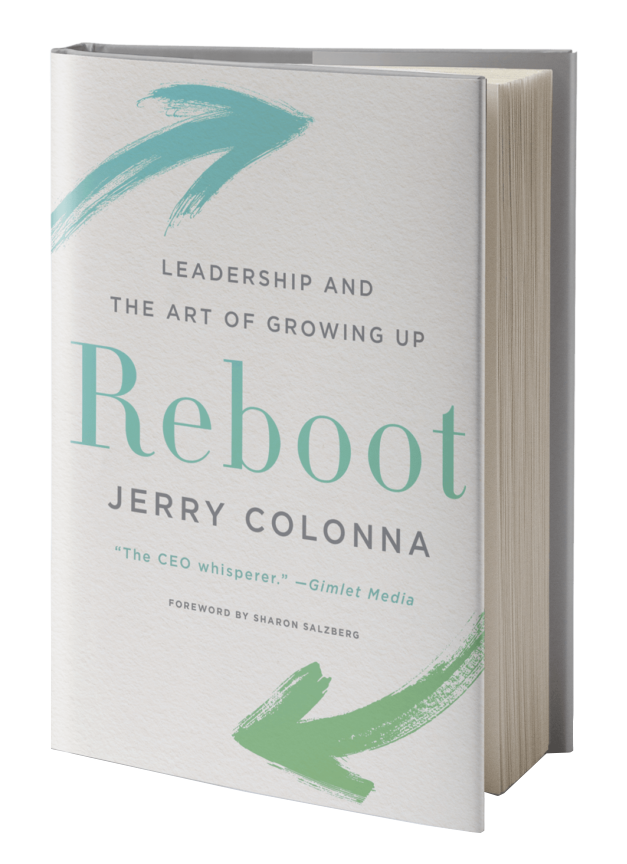The ultimate definition of resilience is to see that the world is always changing.
In our Dear Reboot series, Reboot coaches aim to provide guidance on common leadership dilemmas. If you’d like to submit a question to be considered for our Dear Reboot column, email us here.
. . .
Dear Jerry,
First, I just want to say how grateful I am for you and your work. I first discovered the Reboot podcast when I was going through a particularly challenging period at work and I found it to be a haven. A source of wisdom and catharsis. A frequent reminder of our profound shared humanity. Your episode with Sharon Salzberg, in particular, is one I’ve found myself both revisiting and frequently sharing with friends who need it.
Your book has been an even greater gift, arriving when I was the better part of a year into my startup journey. You made your hard questions feel real and accessible. Your metaphors give a powerful embodiment to these complex ideas allowing me to readily carry them with me. I’ve found myself revisiting it in the midst of all the craziness of the last few weeks which has left me with a nagging question — how do you recognize the difference between resilience and false grit (and is the line between them always so clear)?Because having a strong back means confronting hard things and persisting even when it’s painful. Sometimes, the Sastrugi of our lives feel less like tiny ridges and more like endless mountains. Sometimes it’s possible to find the presence to stay in the moment and face them with equanimity, to find purpose in the alignment between what I’m doing and who I am even if it’s hard. But, other times the fire only comes from the longer sense of purpose; from believing that the present pain is bearable because it gets us to the other side of the continent. And sometimes that purpose is mixed with fear too — fear of failure, fear of foolishness, and for me usually fear of regret.
For me the challenge is that usually I find myself with both — the fire and the fear. And that lets me do hard things, it gives me a strong back when I need it. It lets me persist when the optimism has worn off. But sometimes, it also keeps me going when I shouldn’t, trapped by the false grit or the attachment to an outcome. It keeps me sailing into the wind when I should be tacking right.
I suppose, fundamentally what I’m asking is how can I tell the difference between stubbornness and strength? How do I tell when the two are neighbors? How can I have a strong back, but not a brittle one?
I find myself asking the very real question of whether my business can survive what comes next while also trying to stay focused in the midst of a news cycle that is hard to escape. I feel like I’ve come too far to give up now but the anxiety is real. I want to stay strong, but I don’t want to ignore facts either.
With gratitude,
Krishna
. . .
Dear Krishna,
Let me respond to your question about stubbornness vs strength (as you put it) or, as I might say, false grit vs true grit. One way to check is to see how it feels to alter your view of the world. If, for example, the realization that the winds have shifted (as they seem to have economically right now) causes you to be afraid and, in response, your body (and mind) tense up and the Crow squawks that you’re being weak if you shift direction, then you’re probably operating from a place of false grit. Good leadership, true grit leadership, sees the shifts for what they are: merely change and not a personal affront. We see that change and adjust accordingly.
For example, leaders should enter the start of a quarter with a view of how the upcoming months will unfold. When the data of how the world is actually behaving becomes clear, then we need to be resilient enough to flex and shift (perhaps cutting expenses, or preserving cash, or taking a look again at pricing) while looking deeply into the market to see what our customers may need NOW (as opposed to when we devised our plans in the first place).
Your note reminds me of a friend who asked, “When will the market hit bottom?” I smiled and said, “Calling the bottom is nearly impossible.” The best you can do is establish your own floor, your own bottom, your own bottom-line, and do the best you can to respond from there.
Those who hold steadfastly to the mission they first forecast months before, despite hearing conflicting or contradictory messages, are likely to be in the grips of false grit.
In similar fashion, times like these demand that a leader increase their communications…that way you can feel as well as listen for the signals that indicate it’s time to adjust the sails.
Lastly, I can share what I am doing with regard to the news…I continue to pay attention to the news but I am doubling down on listening to my heart and the hearts of those around me.
I suppose, in the end, I’m trusting in community to not only tell me when I’m relying too much on stubbornness and not enough on my ability to be flexible but to help me manage my reactions. The world may be changing but it’s not ending. And, I suppose, that’s the ultimate definition of resilience, to see that the world is always changing. Accepting that fact is, I suppose, the ultimate expression of true grit.
May that be helpful to you. May you be helpful to others and find the balm for your anxious heart that comes from compassionately serving others.
Love,
Jerry
 Leadership and the Art of Growing Up
Leadership and the Art of Growing Up
One of the start-up world’s most in-demand executive coaches—hailed as the “CEO Whisperer”—reveals why radical self-inquiry is critical to professional success and healthy relationships in all realms of life.
